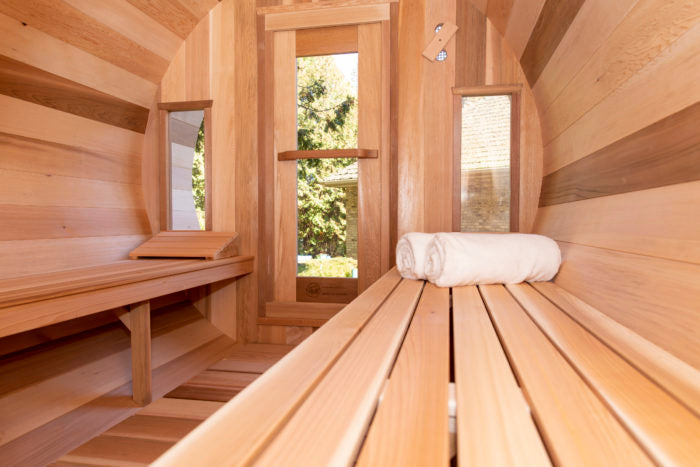5 Easy Facts About Traditional Sauna Explained
Some Of Traditional Sauna
Table of ContentsThe 10-Second Trick For Traditional SaunaMore About Traditional SaunaThe Best Guide To Traditional Sauna7 Easy Facts About Traditional Sauna DescribedThe 3-Minute Rule for Traditional Sauna
Many of the weight shed in a sauna is water loss and is re-gained upon rehydrating. Without an uncertainty sauna can be a vital component of a healthy and balanced weight loss program. To take a look at the distinctions in between typical and IR saunas, I will separate these into proven, theoretical, and fabricated distinctions.Thus, the best point in the saunawhich is at the ceiling straight above the sauna heateris typically between 185 and 190 F. Claims that a typical sauna exceeds 200 F is merely not true and not applicable for electrical saunas marketed in the US. The temperature for a far-infrared sauna is typically set in between 120 and 140 F; nonetheless, unlike the conventional sauna, the goal in and IR area is not to accomplish a heat.
Due to the fact that of this, the temperature difference is virtually pointless, because excessive sweating results in both sauna types, yet the technique of warming the body is different. In an IR sauna the bather will feel warm and will sweat a lot, but at much reduced temperature levels (Traditional Sauna). Therefore, if the objective is to spend longer amount of times in the sauna, the IR sauna is an excellent choice
When a standard sauna has actually been properly heated, the sauna walls are warm, the air temperature level has attained set temperature and the rocks are extremely heated. As a fascinating side note, the warmed wall surfaces and the rocks are releasing far-infrared warm, integrated with the warmed air, to create an "covering heat".
What Does Traditional Sauna Mean?

When the high temperature is attained, the aspects cycle on and off to maintain the heat. Most typical sauna customers enjoy pouring water over the rocks to create vapor to increase sauna humidity levels. The benefits of pouring water over the rocks include: making the room much more comfy, moistening the nasal passages, and enabling the usage of aromatherapy by blending necessary oils with the water.

When the energy gets in the body, it triggers the body temperature to increase and ultimately results in sweating. In an infrared sauna it is necessary for the emitters/heaters to continue to be on virtually continuously. Considering that there is no mass of rocks to keep heat, the sauna will certainly cool if the emitters shut down.
As stated above, the sauna bather in an infrared room wishes to position himself in front of running emitters to get maximum gain from the warm. The heating time for the 2 rooms can be very various, depending on just how the rooms are link made use of. For a typical sauna, a bather ought to enable 30-40 minutes for the space to achieve a desired temperature level and Traditional Sauna to effectively pre-heat the rocks.
Rumored Buzz on Traditional Sauna
A well built sauna will usually achieve a temperature level of 150-160 F in regarding 30-40 mins. For hotter temperature levels, the room may require to warmth for a longer duration. As soon as the room accomplishes set temperature, the heater will certainly cycle on and off, normally running about 50% of the moment. The shielded wall surfaces and the warmed rocks will certainly keep the room warm and at steady temperatures.

Traditional saunas often tend to be bigger (for this reason utilize more electrical power) than infrared saunas, although typical saunas are certainly readily available in one and 2 person dimensions. For a two-person standard sauna, 5x6 or 5x7 dimension is most prominent. The top bench can conveniently seat two or 3 people and is also enough time to rest during the sauna session.
Some Of Traditional Sauna
The ordinary price per kWH of power in the U.S. is about $0.11, so a 4.5 kW heating unit will cost about $.50 to compete one hour, if the heating unit runs continuously for one hour. Commonly a sauna heating system will compete 75% of the first hour and find more info 50% of succeeding hours on considering that the elements cycle once the established temperature is achieved.

Finally, there is a rarely talked about difference in the social experience between both rooms. While our society has shed a few of the social advantage of the typical sauna experience, it can be really socially rewarding (Traditional Sauna). From family time in the sauna, to heart-felt conversations with considerable others, to sauna partiesthe typical sauna experience can cause intimate mingling
Indicators on Traditional Sauna You Need To Know
The majority of higher end infrared areas include tinted light therapy, stereo and full-glass fronts. The size of many rooms permit 2 people to easily utilize the area, while some layouts may allow for a third or fourth individual to make use of the room. Custom-made infrared areas are also offered, with area sizes offered as much as 7' x 8' x 7' high.